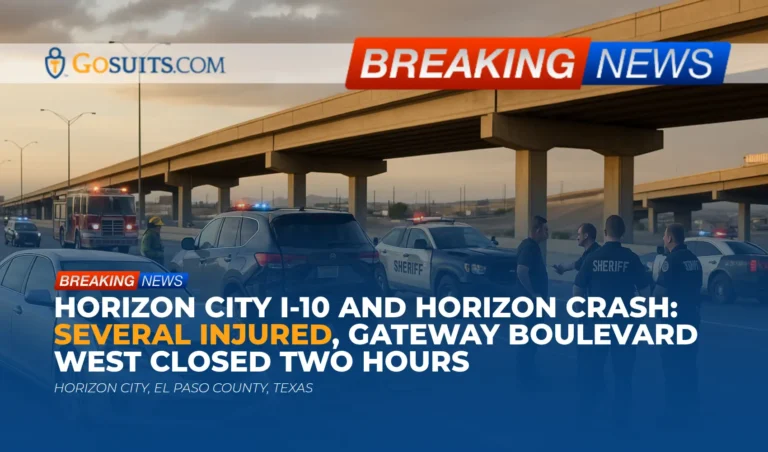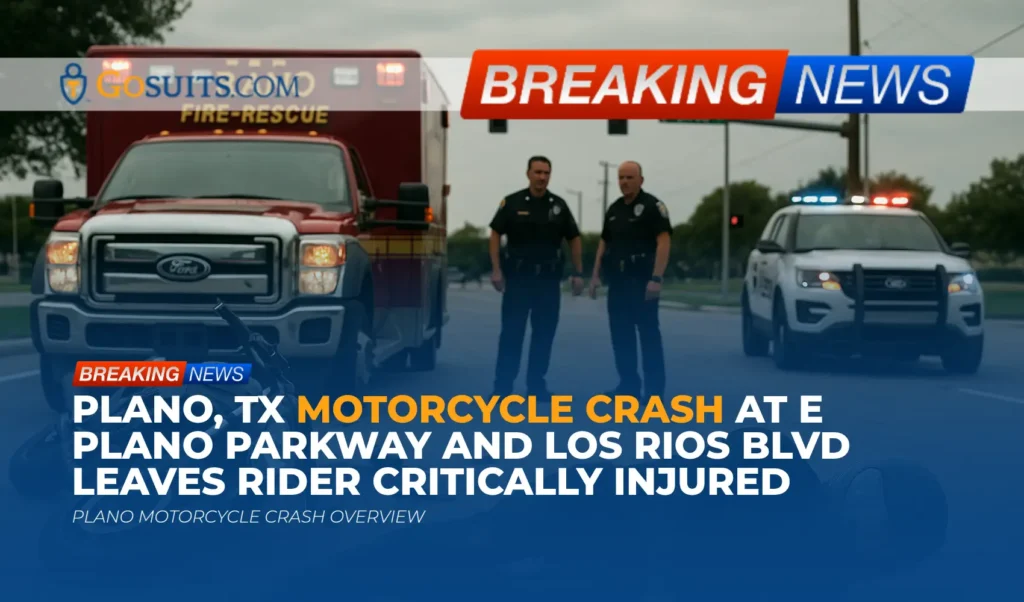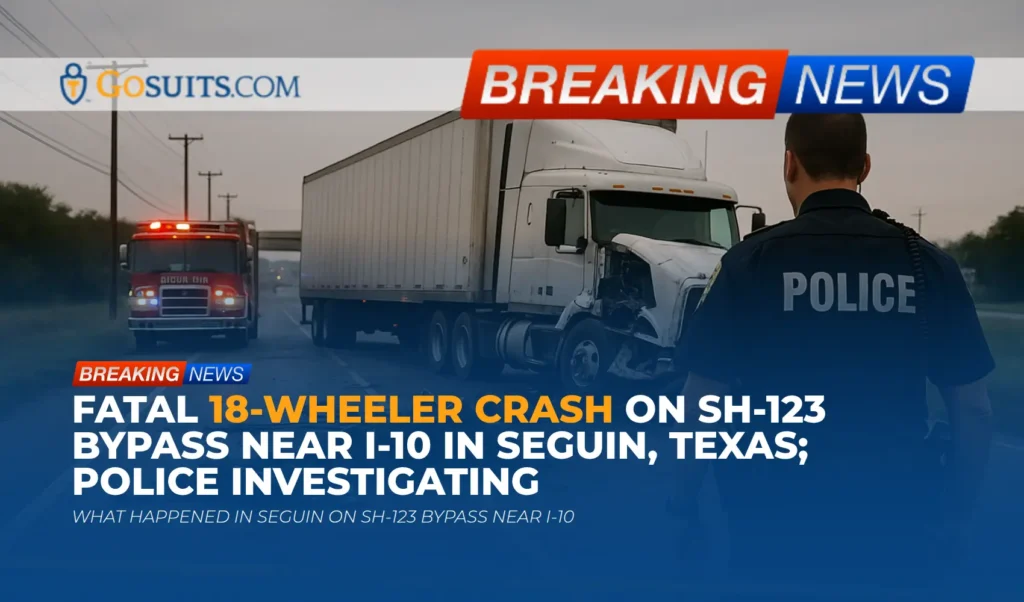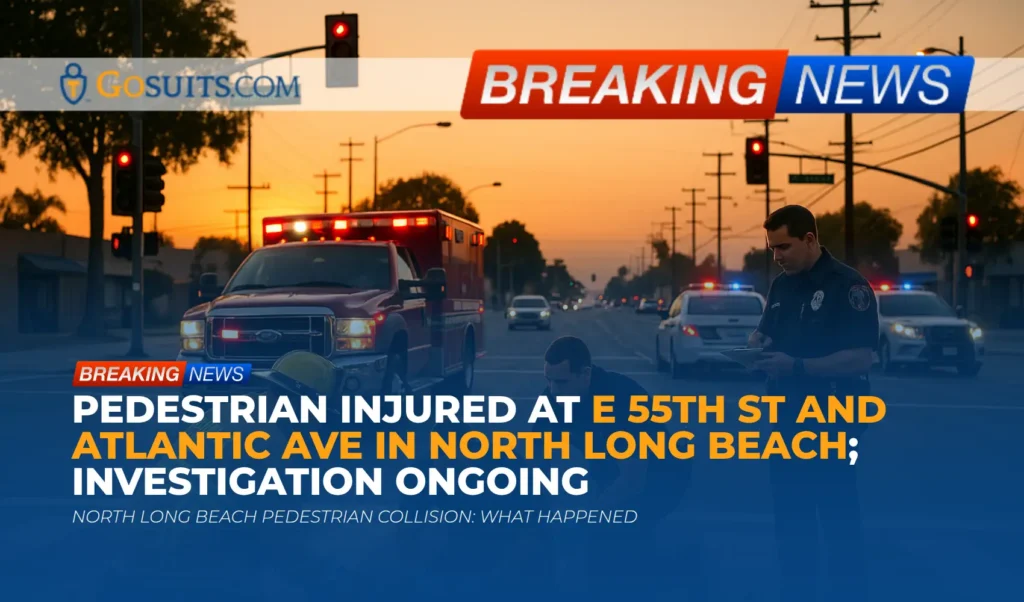- Overview of the Horizon City multi-vehicle crash
- What is known so far
- Road closures and traffic impacts near I-10 and Horizon
- Why multi-vehicle crashes happen at freeway interchanges
- Injury care after a crash and why follow-up matters
- Your rights and timelines in Texas civil injury cases
- Insurance and claims after a multi-vehicle collision
- Evidence to preserve and how to document your loss
- How to get official records and where to call
- Safety context and data for Texas roadways
- Community safety reminders for the I-10 corridor
- Commentary from Gosuits Horizon City, Texas Personal Injury Attorney
- Call-to-Action: Why acting now matters
Overview of the Horizon City multi-vehicle crash
A multi-vehicle collision occurred on Wednesday evening in Horizon City at the interchange of Interstate 10 and Horizon. According to the El Paso County Sheriff’s spokesperson, three vehicles were involved and several people sustained minor injuries. Multiple patients were transported to area hospitals. Gateway Boulevard West was closed for roughly two hours while crews redirected traffic, removed undrivable vehicles, and cleared debris from the roadway.
This article is written to help those affected understand what typically follows a crash like this, what records are available, and how Texas civil law generally addresses multi-vehicle collisions. It also offers practical steps for documenting injuries and losses and explains why seeking a free consultation with a seasoned personal injury attorney before dealing with insurance adjusters can help protect a claim.
What is known so far
Summary of the incident
- Location: I-10 and Horizon, Horizon City, El Paso County, Texas.
- Date and time: Wednesday evening, January 31, 2024.
- Vehicles involved: Three.
- Injuries: Several individuals with reported minor injuries; multiple transports to hospital.
- Traffic impacts: Gateway Boulevard West closed about two hours; traffic diverted to Horizon during towing and debris removal.
- Agency involved: El Paso County Sheriff’s Office.
When a crash involves several vehicles, law enforcement typically documents the scene, photographs the resting positions of vehicles, notes roadway conditions, and records witness information. The official crash report in Texas is called a CR-3 and is filed with the Texas Department of Transportation. Members of the public can later purchase that report, which often includes diagrams, narratives, and potential contributing factors.
Road closures and traffic impacts near I-10 and Horizon
Clearing multi-vehicle collisions on high-speed corridors like the I-10 frontage roads and ramps requires careful coordination. Traffic Incident Management practices used by transportation and law enforcement agencies prioritize quickly rescuing the injured, protecting responders, and restoring normal traffic flow. The Federal Highway Administration highlights that organized incident response reduces secondary crashes and improves safety for everyone approaching the scene. See FHWA’s overview of Traffic Incident Management for context at ops.fhwa.dot.gov/eto_tim_pse.
A two-hour closure for towing and debris clearance following a multi-vehicle collision at a busy interchange is not unusual. These delays also commonly happen because investigators must complete measurements or capture scene photographs before vehicles are moved.
Why multi-vehicle crashes happen at freeway interchanges
Interchanges concentrate merging, exiting, and lane changes in a short distance. Chain-reaction collisions can occur when one sudden stop or unsafe maneuver triggers a sequence of impacts. Some contributing factors commonly seen in multi-vehicle collisions include:
- Speeding: At higher speeds, stopping distances increase and mistakes leave little room to avoid a crash. NHTSA reports that speeding reduces a driver’s ability to steer safely around curves or objects and extends the distance necessary to stop. See NHTSA’s resource at nhtsa.gov/risky-driving/speeding.
- Following too closely: Tailgating decreases reaction time and is a frequent factor in chain-reaction rear-end collisions.
- Distracted driving: Even a short glance away from the road can cause a driver to miss a sudden slowdown. NHTSA provides details on distraction risks at nhtsa.gov/risky-driving/distracted-driving.
- Lane change conflicts: Late merges at exits and entrances often cause abrupt braking or sideswipe collisions.
- Visibility and debris: Dust, darkness, or unexpected debris in the roadway can lead to sudden braking and secondary impacts.
These are general risk factors seen across Texas highways. The specific causes in this Horizon City collision will be reflected in the law enforcement crash report and any subsequent reconstruction work if conducted.
Injury care after a crash and why follow-up matters
The initial report notes several people suffered minor injuries. In the hours after a collision, it is common for pain and stiffness to increase as adrenaline wears off. Soft tissue injuries, concussions, and internal injuries are sometimes not obvious at the scene. Timely evaluation can catch problems early and creates a clear medical record linking symptoms to the crash.
Patients generally have a right to obtain their medical records, including imaging and discharge summaries. The U.S. Department of Health and Human Services explains the right of access under HIPAA, which allows individuals to receive copies of their medical records, usually within 30 days of a written request. See HHS guidance at hhs.gov/hipaa/for-professionals/privacy/guidance/access. Keeping complete copies of these records is important for insurance claims and any potential civil case.
If symptoms worsen or new symptoms appear in the days following the crash, follow-up with a healthcare provider is critical. Gaps in treatment can make it harder to show that injuries were caused by the collision. Documenting pain levels, limitations at work or school, and the need for assistance with daily tasks can also help show the real impact of injuries.
Your rights and timelines in Texas civil injury cases
Texas civil law sets time limits for bringing claims. Generally, the statute of limitations for personal injury is two years from the date of the incident. See Texas Civil Practice and Remedies Code section 16.003 at statutes.capitol.texas.gov/Docs/CP/htm/CP.16.htm#16.003. There can be shorter notice deadlines if a government entity is involved, and there are exceptions in some circumstances, so getting timely legal guidance is important to preserve options.
Texas also follows a proportionate responsibility system for negligence. A person can recover damages as long as they are not more than 50 percent responsible for the incident, and any award is reduced by their percentage of responsibility. See Texas Civil Practice and Remedies Code Chapter 33 at statutes.capitol.texas.gov/Docs/CP/htm/CP.33.htm. In multi-vehicle cases, fault may be shared among several drivers, which makes careful investigation and evidence preservation essential.
Insurance and claims after a multi-vehicle collision
Texas is an at-fault state, which means the driver who caused the crash, and their insurer, is generally responsible for paying for injuries and property losses up to policy limits. The Texas Department of Insurance provides consumer resources on auto coverage and claims at tdi.texas.gov/pubs/consumer/cb020.html.
Common coverages that may apply
- Bodily injury liability: Pays for injuries the at-fault driver causes to others, up to the policy limits.
- Property damage liability: Pays for damage to other vehicles or property.
- Personal Injury Protection: In Texas, insurers must offer PIP; if purchased, it can help pay medical bills and certain related costs regardless of fault. See TDI’s overview of auto insurance coverages at tdi.texas.gov/pubs/consumer/cb020.html.
- Uninsured/Underinsured Motorist: May apply if an at-fault driver has no insurance or insufficient limits.
- Collision coverage: May help repair or replace your vehicle regardless of fault, subject to the deductible.
Practical tips before making a claim
- Speak with an attorney first: Before giving any statement to an insurance company, consider a free consultation with a personal injury attorney. What is said to an insurer can be used later to challenge fault or minimize injuries.
- Do not guess: If an adjuster asks about speed, distances, or timing and you are unsure, say you do not know rather than guessing.
- Gather your records: Insurers will want the crash report, photos, medical records, and repair estimates. Organize these early.
- Be cautious with releases: Do not sign medical releases that allow broad access to unrelated health history without understanding the scope.
Evidence to preserve and how to document your loss
Evidence can fade quickly after a crash, especially at busy interchanges where crews must clear lanes. Taking the following steps can help protect a claim:
- Photographs and videos: Capture vehicle damage, skid marks, debris fields, lane markings, and traffic signals. If safe, photograph the approach from the direction of travel.
- Witness contacts: Obtain names and phone numbers of bystanders or other drivers who saw the crash or its lead-up.
- Dash camera footage: Preserve any in-vehicle footage. Make backup copies and note the date and time settings.
- Vehicle data: Modern vehicles often store event data like speed and braking. Ask your repair shop to preserve this data. In more severe cases, an attorney can help secure this information.
- Medical documents: Save visit summaries, imaging, prescriptions, and therapy notes. Keep a symptom journal describing pain levels and daily impacts.
- Employment records: Keep pay stubs, time-off records, and statements from supervisors if injuries affected work.
- Property damage estimates: Obtain at least two written estimates, and keep all towing and storage invoices.
How to get official records and where to call
Official documents help establish what happened and the extent of losses. In a multi-vehicle crash, these records are commonly available:
Texas CR-3 crash report
- What it is: The law enforcement crash report filed with TxDOT, often containing a diagram, narratives, and contributing factors.
- Where to get it: Through the Texas Department of Transportation’s online portal at cris.txdot.gov/public/Purchase. You’ll need at least one of the following: name of a person involved, date of crash, and crash location.
911 call logs and CAD entries
- What it is: Records of emergency calls and dispatch times. These can corroborate timelines and location details.
- Where to ask: The El Paso County Sheriff’s Office maintains dispatch records for calls in its jurisdiction. Requesting these is typically done through a public information request to the agency’s records unit. Texas Public Information Act guidance is available from the Texas Attorney General at texasattorneygeneral.gov/open-government/governmental-bodies/public-information-act.
Photos and scene diagrams
- What it is: Some agencies take additional photos or measurements beyond what appears in the crash report.
- Where to ask: Request from the investigating agency’s records unit. Provide the incident number if available.

Medical records
- What it is: ER records, imaging, physician notes, and therapy summaries documenting injuries and treatment.
- Where to get it: Request directly from the hospital or clinic. Patients have a federal right to access their records under HIPAA. See HHS guidance at hhs.gov/hipaa/for-professionals/privacy/guidance/access.
Autopsy or death investigation records in fatal cases
- What it is: If a crash results in a fatality, the medical examiner or a justice of the peace may conduct an inquest. Autopsy reports are generally public records in Texas, with restrictions on certain materials like photographs.
- Legal basis: Texas Code of Criminal Procedure Article 49.25 and related provisions govern medical examiner duties and records. See statutes.capitol.texas.gov/Docs/CR/htm/CR.49.htm#49.25.
- Where to ask: Requests typically go to the county medical examiner’s office or justice court that handled the case. In El Paso County, a medical examiner’s office serves the region. Call the county switchboard to be directed to records if the specific office contact is not known.
Who to call locally
- Emergency or active danger: 911.
- El Paso County Sheriff’s Office non-emergency: Commonly listed as 915-546-2280. Call to confirm the report number and records request procedure. If unsure, ask for the Records Unit.
- TxDOT Crash Records: Use the online portal at cris.txdot.gov/public/Purchase for CR-3 reports.
- Hospitals: Call the hospital’s Health Information Management or Medical Records department to request patient records. Provide photo ID and the dates of service.
- Medical examiner or justice court: For autopsy or inquest information, call the El Paso County administrative line and ask to be routed to the appropriate office for records.
If a government entity is involved in a collision response or a government vehicle was part of the crash, there may be special notice requirements. Those deadlines can be much shorter than the standard statute of limitations, so consider speaking with a personal injury attorney promptly to understand the timelines that may apply.
Safety context and data for Texas roadways
Texas experiences a significant number of multi-vehicle collisions each year. The Texas Department of Transportation publishes annual crash facts and statistical summaries that provide insight into patterns statewide. See TxDOT’s crash statistics resources at txdot.gov/about/driver/traffic-safety/crash-statistics.html.
Nationally, federal agencies offer safety insights relevant to urban freeway interchanges:
- NHTSA on speeding and distraction: Speeding and distracted driving remain persistent contributors to crashes. Resources are available at nhtsa.gov/risky-driving/speeding and nhtsa.gov/risky-driving/distracted-driving.
- CDC transportation safety: The Centers for Disease Control and Prevention maintains resources on road user safety at cdc.gov/transportationsafety.
- FHWA incident management: Coordinated roadway incident response helps reduce secondary crashes around congestion and closures. See ops.fhwa.dot.gov/eto_tim_pse.
While statewide statistics cannot determine the cause of a specific collision, they help explain why agencies emphasize safe speeds, attentive driving, and patient merging at busy interchanges like I-10 and Horizon.
Community safety reminders for the I-10 corridor
- Approach interchanges with extra space: Leave more following distance as you approach ramps where merging and exits occur.
- Scan far ahead: Watch brake lights and traffic movement two to three vehicles ahead. Cover the brake in congested areas.
- Signal early: Signal lane changes well in advance, avoid abrupt maneuvers, and check mirrors and blind spots carefully.
- Keep speeds steady: Maintain a safe, consistent speed through frontage road transitions and ramp merges.
- Secure loads: Ensure cargo is properly tied down to prevent debris-related hazards for drivers behind you.
Commentary from Gosuits Horizon City, Texas Personal Injury Attorney
Our hearts go out to everyone affected by the Horizon City multi-vehicle crash at I-10 and Horizon. We are relieved that initial reports describe the injuries as minor, and we wish those injured a full and steady recovery. This article is offered for educational purposes and general information to help the community understand next steps and rights after a crash.
Multi-vehicle collisions at interchange areas are uniquely complex. Even when injuries seem mild at the scene, the physical and financial impacts can grow over the next days and weeks. Liability can be disputed among several drivers, and contributing factors often include following distance, speed, and quick decision-making during lane changes or merges. The official crash report and any supplemental records are essential tools for understanding fault and protecting a civil claim.
Insurance companies and large corporations often move quickly after a collision. Adjusters may ask for recorded statements, broad medical authorizations, or early settlements before the full extent of injuries is known. These requests can shift the narrative around fault or minimize the value of a claim. Simple statements made while under stress can be taken out of context later. That is why it is important to consult with a skilled attorney before speaking in detail to any insurer. A free consultation helps clarify rights, identify deadlines, and plan how to gather and secure key evidence.
For those navigating injuries after a crash, knowledge is power. Understanding the Texas proportionate responsibility rules, the two-year limitations period for personal injury, and how to obtain CR-3 reports, 911 logs, and medical records can make a meaningful difference. An initial consultation can help organize these steps, protect timelines, and ensure that communications with insurers are accurate and appropriately limited.
Call-to-Action: Why acting now matters
What to do next
- Get the CR-3 crash report: Use the TxDOT portal to obtain the official report. Confirm all details match your recollection and correct any errors through the investigating agency as appropriate.
- Consolidate medical care: Schedule follow-up appointments, keep all receipts, and request copies of imaging and visit notes.
- Preserve evidence: Save photos, dashcam footage, and damaged property. Notify your repair facility not to discard parts before documentation.
- Record the financial impact: Track missed work, out-of-pocket expenses, transportation costs to appointments, and any family help required for daily tasks.
- Consult an attorney before insurer statements: Discuss your situation and your rights. What you say to an insurer now can be used against you later.
Why timing is important
- Deadlines can be short: Texas personal injury claims are generally subject to a two-year statute of limitations, and some notices are much shorter when government entities are involved.
- Evidence disappears: Skid marks fade, debris is cleared, and vehicles are repaired or sold. Early preservation strengthens a claim.
- Medical causation needs continuity: Consistent treatment creates a clear connection between the collision and the symptoms, which matters for negotiations and potential litigation.
- Insurers move fast: Early outreach by adjusters can shape the record. Understanding your rights before engaging helps prevent missteps.
Context for the Horizon City incident
- Busy interchange: I-10 and Horizon combines freeway speeds with frontage road traffic and multiple ramp movements. Multi-vehicle collisions at such junctions often involve disputed accounts from several drivers.
- Roadway clearance: The roughly two-hour closure aligns with standard incident management practices prioritizing safety and thorough documentation.
- Minor injuries can evolve: Pain and stiffness commonly intensify in the days after a crash. Early and ongoing medical evaluation protects health and helps document the timeline.
Acting promptly helps preserve options, clarifies responsibilities, and reduces the risk that important details are lost. Even when injuries are initially described as minor, a careful, step-by-step approach protects both health and any potential claim.
Legal perspective on multi-vehicle liability
Although the specific causes of this Horizon City crash remain under investigation, multi-vehicle liability in Texas typically focuses on whether one or more drivers failed to use ordinary care, and whether that failure caused or contributed to the collision. Examples of potentially negligent acts include following too closely, unsafe speed for conditions, unsafe lane changes, or failing to yield during merges. If more than one driver shares responsibility, Texas proportionate responsibility rules allocate fault by percentage and adjust damages accordingly. See Texas Civil Practice and Remedies Code Chapter 33 at statutes.capitol.texas.gov/Docs/CP/htm/CP.33.htm.
In some collisions, additional parties may be relevant. For example, if a nonparty’s debris caused a sudden hazard, or if a vehicle had a mechanical failure due to recent service, more investigation may be warranted. If any involved vehicle was being used for work or was a commercial vehicle, there may be separate insurance policies or corporate defendants. This requires careful fact development and review of all available records, including the CR-3 report, photos, repair records, and potential vehicle data.
Notes about dealing with insurers
- Property claims: You may choose to go through your own collision coverage for faster repairs, then your insurer may seek reimbursement from the at-fault insurer.
- Medical payments and PIP: If PIP was purchased, it can help with medical bills and certain related costs regardless of fault. See TDI’s consumer guide at tdi.texas.gov/pubs/consumer/cb020.html.
- Recorded statements: Decline until you have consulted an attorney. Provide only basic information necessary to open a claim, and avoid discussing fault or injuries in detail.
- Releases and settlements: Early settlements may not account for future medical needs. Review any proposed release carefully before signing.

Documentation checklist
- From the scene: Photos of vehicle damage, roadway layout, skid marks, and any visible injuries.
- From law enforcement: TxDOT CR-3 crash report, 911 call logs, and any supplemental photos or measurements.
- From medical providers: ER records, specialist notes, imaging, prescriptions, and therapy records.
- From work: Pay stubs, employer verification of missed days, and any disability accommodations.
- From the repair process: Towing bills, storage fees, and repair estimates, with photos of undercarriage damage.
- Personal journal: Daily notes on pain, sleep disruption, limits on household chores, and emotional impact.
Practical steps to protect health and a potential claim
- Follow your treatment plan: Attend all appointments and therapy sessions. Gaps can be used to question causation or severity.
- Keep communications simple: When speaking with insurers, stick to basics like names, policy numbers, and location of vehicles for inspection. Avoid opinions on fault or medical diagnoses.
- Use written requests: Request records in writing and keep copies. Note the dates requests were made to track response times.
- Consider an attorney’s guidance: A free consultation can help map out a strategy, identify additional sources of recovery, and manage communications with insurers.
Helpful government resources
- TxDOT crash reports: cris.txdot.gov/public/Purchase
- TxDOT crash statistics: txdot.gov/about/driver/traffic-safety/crash-statistics.html
- Texas auto insurance basics: tdi.texas.gov/pubs/consumer/cb020.html
- HIPAA right of access: hhs.gov/hipaa/for-professionals/privacy/guidance/access
- Texas statute of limitations: statutes.capitol.texas.gov/Docs/CP/htm/CP.16.htm#16.003
- Texas proportionate responsibility: statutes.capitol.texas.gov/Docs/CP/htm/CP.33.htm
- Texas Public Information Act: texasattorneygeneral.gov/open-government/governmental-bodies/public-information-act
- FHWA incident management: ops.fhwa.dot.gov/eto_tim_pse/
- NHTSA speeding: nhtsa.gov/risky-driving/speeding
- NHTSA distracted driving: nhtsa.gov/risky-driving/distracted-driving
- CDC transportation safety: cdc.gov/transportationsafety
A respectful closing note on the Horizon City crash
Crashes like the one at I-10 and Horizon upend a normal evening in an instant. While initial reports indicate minor injuries, even these can mean lost time, medical bills, and anxiety about the next steps. Taking a calm, organized approach to medical care, documentation, and record requests can make recovery smoother. When in doubt about your rights, consider a free consultation with a seasoned attorney before making detailed statements to any insurance company. In a multi-vehicle setting, that guidance can help ensure your story is heard clearly and that your options are preserved.






